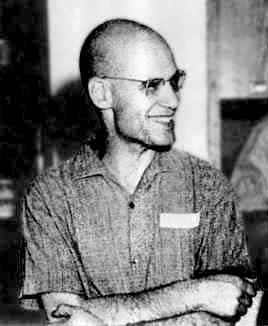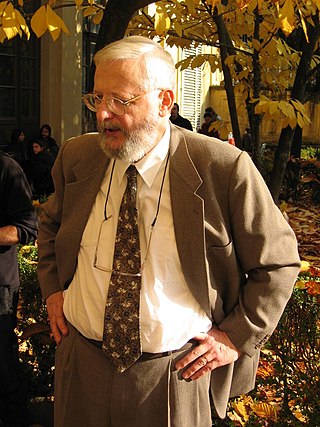
Alexander Grothendieck was a German-born mathematician who became the leading figure in the creation of modern algebraic geometry. His research extended the scope of the field and added elements of commutative algebra, homological algebra, sheaf theory, and category theory to its foundations, while his so-called "relative" perspective led to revolutionary advances in many areas of pure mathematics. He is considered by many to be the greatest mathematician of the twentieth century.
In category theory, a branch of mathematics, a Grothendieck topology is a structure on a category C that makes the objects of C act like the open sets of a topological space. A category together with a choice of Grothendieck topology is called a site.
In mathematics, a sheaf is a tool for systematically tracking data attached to the open sets of a topological space and defined locally with regard to them. For example, for each open set, the data could be the ring of continuous functions defined on that open set. Such data are well behaved in that they can be restricted to smaller open sets, and also the data assigned to an open set are equivalent to all collections of compatible data assigned to collections of smaller open sets covering the original open set.
The following outline is provided as an overview of and guide to category theory, the area of study in mathematics that examines in an abstract way the properties of particular mathematical concepts, by formalising them as collections of objects and arrows, where these collections satisfy certain basic conditions. Many significant areas of mathematics can be formalised as categories, and the use of category theory allows many intricate and subtle mathematical results in these fields to be stated, and proved, in a much simpler way than without the use of categories.
In category theory, a subobject classifier is a special object Ω of a category such that, intuitively, the subobjects of any object X in the category correspond to the morphisms from X to Ω. In typical examples, that morphism assigns "true" to the elements of the subobject and "false" to the other elements of X. Therefore, a subobject classifier is also known as a "truth value object" and the concept is widely used in the categorical description of logic. Note however that subobject classifiers are often much more complicated than the simple binary logic truth values {true, false}.
In mathematics, the étale cohomology groups of an algebraic variety or scheme are algebraic analogues of the usual cohomology groups with finite coefficients of a topological space, introduced by Grothendieck in order to prove the Weil conjectures. Étale cohomology theory can be used to construct ℓ-adic cohomology, which is an example of a Weil cohomology theory in algebraic geometry. This has many applications, such as the proof of the Weil conjectures and the construction of representations of finite groups of Lie type.
Motivic cohomology is an invariant of algebraic varieties and of more general schemes. It is a type of cohomology related to motives and includes the Chow ring of algebraic cycles as a special case. Some of the deepest problems in algebraic geometry and number theory are attempts to understand motivic cohomology.

Francis William Lawvere was an American mathematician known for his work in category theory, topos theory and the philosophy of mathematics.
In mathematics, sheaf cohomology is the application of homological algebra to analyze the global sections of a sheaf on a topological space. Broadly speaking, sheaf cohomology describes the obstructions to solving a geometric problem globally when it can be solved locally. The central work for the study of sheaf cohomology is Grothendieck's 1957 Tôhoku paper.
In mathematics, the gluing axiom is introduced to define what a sheaf on a topological space must satisfy, given that it is a presheaf, which is by definition a contravariant functor
In mathematics, injective sheaves of abelian groups are used to construct the resolutions needed to define sheaf cohomology.
In algebraic geometry, the étale topology is a Grothendieck topology on the category of schemes which has properties similar to the Euclidean topology, but unlike the Euclidean topology, it is also defined in positive characteristic. The étale topology was originally introduced by Alexander Grothendieck to define étale cohomology, and this is still the étale topology's most well-known use.
In mathematics, especially in sheaf theory—a domain applied in areas such as topology, logic and algebraic geometry—there are four image functors for sheaves that belong together in various senses.
In mathematics, a topos is a category that behaves like the category of sheaves of sets on a topological space. Topoi behave much like the category of sets and possess a notion of localization; they are a direct generalization of point-set topology. The Grothendieck topoi find applications in algebraic geometry; the more general elementary topoi are used in logic.
In mathematics, a constructible sheaf is a sheaf of abelian groups over some topological space X, such that X is the union of a finite number of locally closed subsets on each of which the sheaf is a locally constant sheaf]. It has its origins in algebraic geometry, where in étale cohomology constructible sheaves are defined in a similar way. For the derived category of constructible sheaves, see a section in ℓ-adic sheaf.
Derived algebraic geometry is a branch of mathematics that generalizes algebraic geometry to a situation where commutative rings, which provide local charts, are replaced by either differential graded algebras, simplicial commutative rings or -ring spectra from algebraic topology, whose higher homotopy groups account for the non-discreteness of the structure sheaf. Grothendieck's scheme theory allows the structure sheaf to carry nilpotent elements. Derived algebraic geometry can be thought of as an extension of this idea, and provides natural settings for intersection theory of singular algebraic varieties and cotangent complexes in deformation theory, among the other applications.
Fiber functors in category theory, topology and algebraic geometry refer to several loosely related functors that generalise the functors taking a covering space to the fiber over a point .
In mathematics, a Lawvere–Tierney topology is an analog of a Grothendieck topology for an arbitrary topos, used to construct a topos of sheaves. A Lawvere–Tierney topology is also sometimes also called a local operator or coverage or topology or geometric modality. They were introduced by William Lawvere and Myles Tierney.
Condensed mathematics is a theory developed by Dustin Clausen and Peter Scholze which, according to some, aims to unify various mathematical subfields, including topology, complex geometry, and algebraic geometry.
In mathematics, a generalized space is a generalization of a topological space. Impetuses for such a generalization comes at least in two forms:
- A desire to apply concepts like cohomology for objects that are not traditionally viewed as spaces. For example, a topos was originally introduced for this reason.
- A practical need to remedy the deficiencies that some naturally-occurring categories of spaces tend not to be abelian, a standard requirement to do homological algebra.

